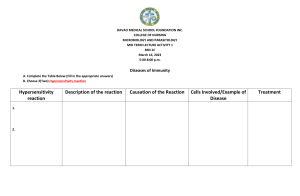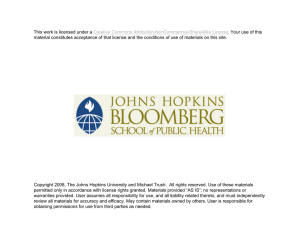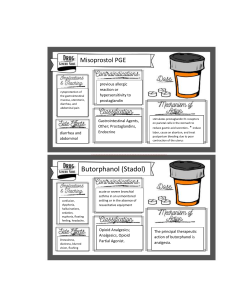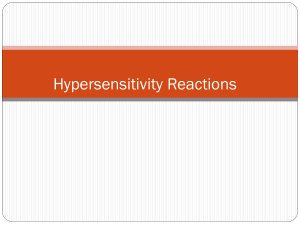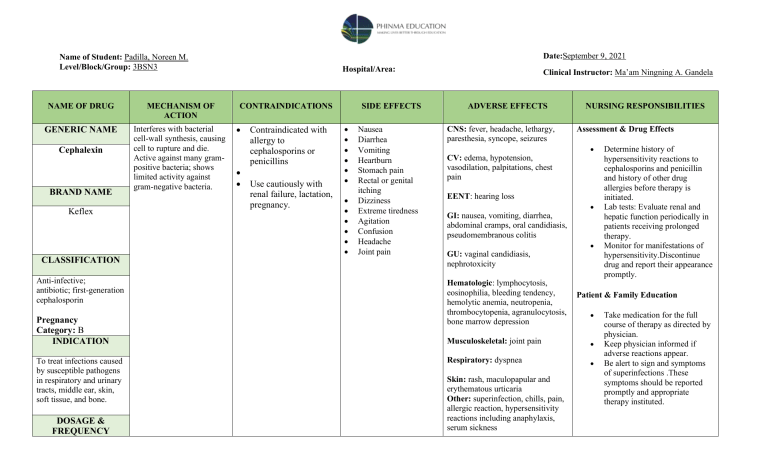
Date:September 9, 2021 Name of Student: Padilla, Noreen M. Level/Block/Group: 3BSN3 NAME OF DRUG MECHANISM OF ACTION GENERIC NAME Interferes with bacterial cell-wall synthesis, causing cell to rupture and die. Active against many grampositive bacteria; shows limited activity against gram-negative bacteria. Cephalexin BRAND NAME Keflex CLASSIFICATION Anti-infective; antibiotic; first-generation cephalosporin Pregnancy Category: B INDICATION To treat infections caused by susceptible pathogens in respiratory and urinary tracts, middle ear, skin, soft tissue, and bone. DOSAGE & FREQUENCY Hospital/Area: CONTRAINDICATIONS Contraindicated with allergy to cephalosporins or penicillins Use cautiously with renal failure, lactation, pregnancy. SIDE EFFECTS Nausea Diarrhea Vomiting Heartburn Stomach pain Rectal or genital itching Dizziness Extreme tiredness Agitation Confusion Headache Joint pain Clinical Instructor: Ma’am Ningning A. Gandela ADVERSE EFFECTS CNS: fever, headache, lethargy, paresthesia, syncope, seizures NURSING RESPONSIBILITIES Assessment & Drug Effects CV: edema, hypotension, vasodilation, palpitations, chest pain EENT: hearing loss GI: nausea, vomiting, diarrhea, abdominal cramps, oral candidiasis, pseudomembranous colitis GU: vaginal candidiasis, nephrotoxicity Hematologic: lymphocytosis, eosinophilia, bleeding tendency, hemolytic anemia, neutropenia, thrombocytopenia, agranulocytosis, bone marrow depression Patient & Family Education Musculoskeletal: joint pain Respiratory: dyspnea Skin: rash, maculopapular and erythematous urticaria Other: superinfection, chills, pain, allergic reaction, hypersensitivity reactions including anaphylaxis, serum sickness Determine history of hypersensitivity reactions to cephalosporins and penicillin and history of other drug allergies before therapy is initiated. Lab tests: Evaluate renal and hepatic function periodically in patients receiving prolonged therapy. Monitor for manifestations of hypersensitivity.Discontinue drug and report their appearance promptly. Take medication for the full course of therapy as directed by physician. Keep physician informed if adverse reactions appear. Be alert to sign and symptoms of superinfections .These symptoms should be reported promptly and appropriate therapy instituted. Mild to Moderate Infection Adult: PO 250–500 mg q6h Child: PO 25–100 mg/kg/d in 4 divided doses Skin and Skin Structure Infections Adult: PO 500 mg q12h Otitis Media Child: PO 75–100 mg/kg/d in 4 divided doses Do not breast feed while taking this drug.
